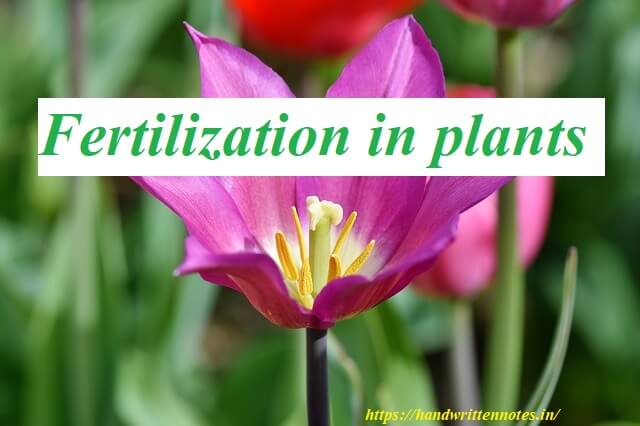Here we will discuss Fertilization in plants, the Definition of fertilization, the Process of fertilization, and the Importance of fertilization in plants. Fertilization is the fusion of male and female reproductive units in the female reproductive organ.
Fertilization Is the process of fusion of two dissimilar sexual reproductive units. Sexual reproductive units are called garments. Gametes Are of two types – male and female gametes. The discovery of fertilization was done by Strasburger in 1884. There are two types of fertilization is involved 1. Generative fertilization and 2. vegetative fertilization. These two processes are collectively called Double fertilization
Major Steps of the Process of Fertilization in plants
There are four major steps of the fertilization process. we will discuss each step in detail.
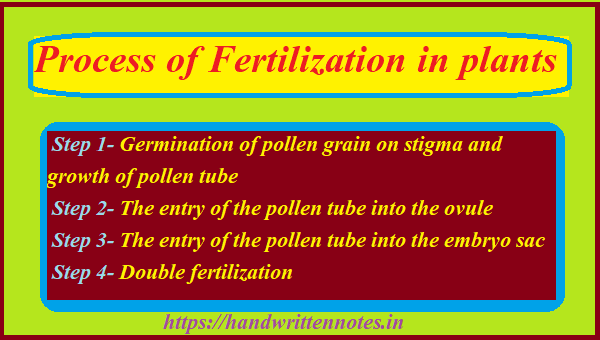
Step 1: Germination of pollen grain on stigma and growth of pollen tube
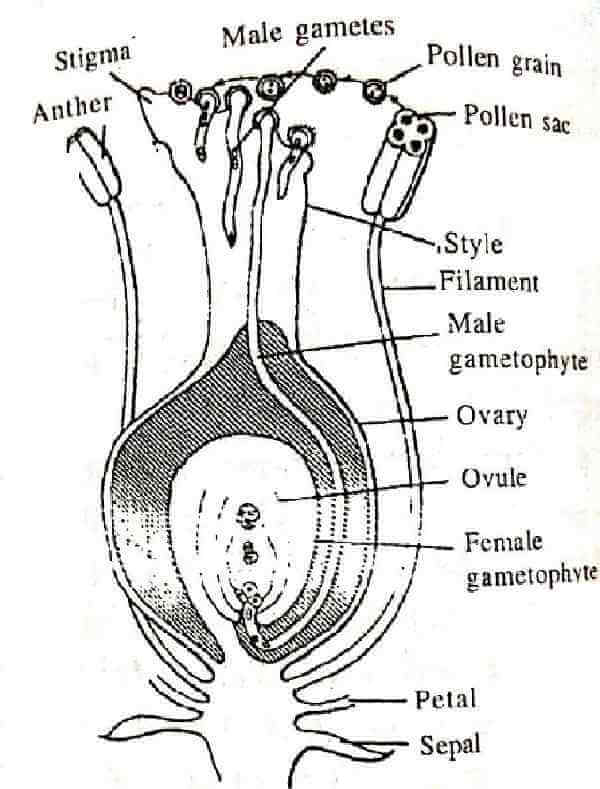
Germination of the pollen grain is the first step of fertilization. At first Pollen grains reach the receptive Stigma of the carpel with the help of the pollination process. Then pollen grains are attached to the stigma.
Now pollen grains absorb water. After absorbing water pollen grains get swelled. Now pollen grain produces a Pollen tube. This Pollen tube grows into stigma towards the ovarian cavity. The pollen tube is very important to mutual recognition and acceptance of pollen grain.
Only one Pollen tube is produced by a Pollen Grain in general cases but in the case of some plants, they produce many Pollen tubes. The pollen tube contains a vegetative nucleus and two male gametes. Vegetative cells are not involved in the fertilization process. Vegetative cells get degenerated after some time.
Pollen tube entry into the ovule
Pollen tube enters the ovule after reaching the ovary. There are various routes to enter the Pollen tube into the ovule. The possible routes of the pollen tube are as follows-
A ) Porogamy- in the case of the Porogamy pollen tube enters the ovule through the micropyle. Porogamy is a very common method by which Pollen tube enters the ovule.
Ex- lily
B) Chalazogamy- in the case of Chalazogamy pollen tube enters into the ovule from the chalazal region. This is less common of entry of pollen tube into the ovule.
Example- Casurina
C) Mesogamy- in the case of Mesogamy pollen tube enters the ovule through its middle part
Ex- Cucurbita, Pistacia
The entry of the pollen tube into the embryo sac
After reaching the Pollen tube into the oval next step is the entry of the pollen tube into the embryo sac. Micropylar region is the only way to enter the pollen tube into the embryo sac. The Pollen tube other passes between a synergid and the egg cell or enters into one of the synergids through filiform apparatus.
The synergids secret chemical substances called chemotropic secretion. These chemical substances direct the growth of the pollen tube. The tip of the pollen tube enters into one synergid. After entry of the pollen tube, synergid starts degenerating. here Pollen tube gets enlarged and ruptures releasing most of its contents. Pollen tube contents are two male gametes and the vegetative nucleus
Double fertilization
Now the nuclei of both male gametes are released into the embryo sac. One male gamete forms the diploid zygote after fusion of with egg. This process is called generative fertilization. Fertilization was discovered by Strasburger in 1884.
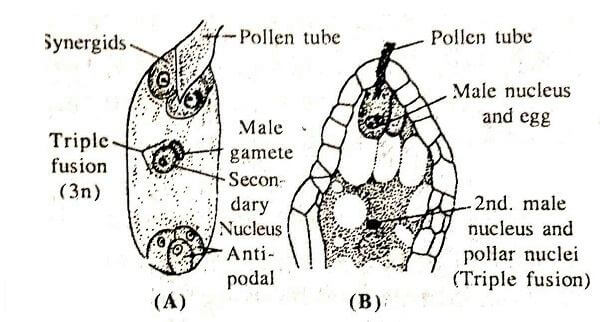
The diploid zygote develops into the embryo. The embryo develops into a complete plant. The Other male gamete fuses with the two polar nuclei to form the triploid primary endosperm nucleus. This process is known as vegetative fertilization. This is also called triple fusion. These two processes of fertilization constitute the process of double fertilization
Read Also
- 12 Major Differences between Self-Pollination and Cross-Pollination
- Pollination: Definition, Types, Agents & Process
- Reproduction in Flowering plants: Types, Process, and Examples
- Dry Fruits Names And Benefits
Note– double fertilization occurs in angiosperms plants only. The five nuclei are involved in double fertilization (two nuclei in balls in syngamy and three nuclei are involved in triple fusion)
FAQs about “Fertilization in plants”
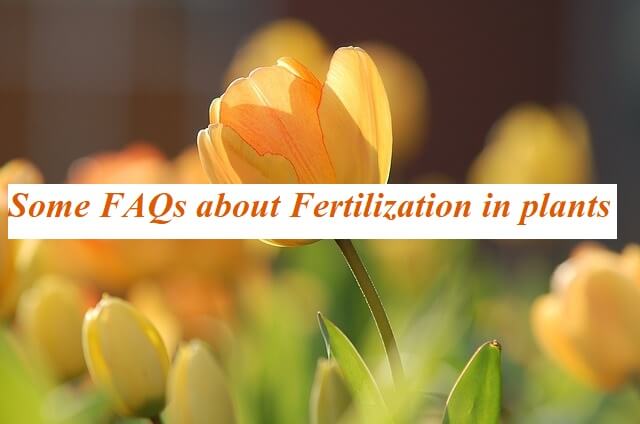
How does fertilization take place in plants?
In the process of fertilization, pollen grains reach the stigma. Then Pollen grains germinated on stigma. Pollen grains start the formation of the pollen tube. Pollen tube enters into ovule then enters into the embryo sac.
Both nuclei of male gametes are released in the embryo sac by the Pollen tube. Here one male gamete fuses with the egg to form a diploid zygote (generative fertilization) and another male gamete fuses with the polar nuclei to form the triploid primary and sperm nucleus (vegetative fertilization). The combination of the two processes Generating fertilization and vegetative fertilization is called double fertilization.
Why is fertilization important in plants?
Fertilization is a very important process to produce new progeny. If fertilization will not take place the fusion of male and female reproductive units will not occur. Show the formation of new progeny will not happen. That’s why fertilization is important in plants and other organisms.
What are the 4 steps of fertilization?
The main four steps of fertilization are 1. Germination of pollen grain on stigma and growth of pollen tube 2. The entry of the pollen tube into the ovule 3. The entry of the pollen tube into the embryo sac 4. Double fertilization
What is double Fertilisation in plants?
The pollen tube releases two male gametes into the embryo sac. Here one male gamete fuses with the egg to form a diploid zygote (Generative fertilization) and another male gamete fuses with the polar nuclei to form the triploid primary and sperm nucleus (vegetative fertilization). The combination of the two processes Generating fertilization and vegetative fertilization is called double fertilization.
Double fertilization in plants?
The combination of the two processes i.e. Generative fertilization and vegetative fertilization is called double fertilization. Both processes occur in the embryo sac of a female ovule.
Read Also
- Water Borne Diseases: Types, Symptoms, Prevention
- Sexually Transmitted Diseases (STDs)- Symptoms, Cause, Effects|(DC)
One liner notes for Plant Fertilization
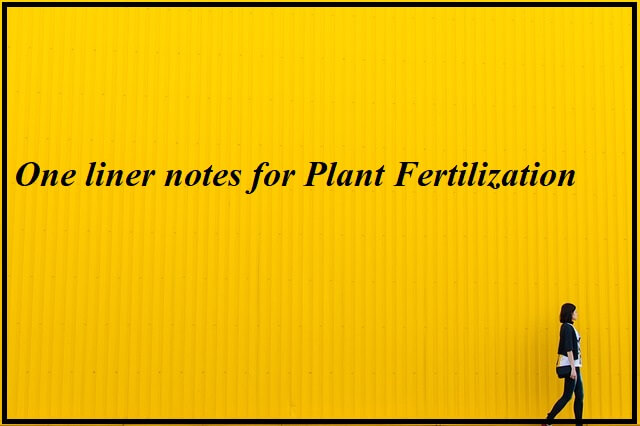
Here we have discussed “Fertilization in plants: Definition, Process and Importance” we hope you like this article. if you have any queries or suggestions, please leave a comment on the email. or contact us from the contact us page.
Follow our official groups on Telegram, Whatsapp, and Facebook

